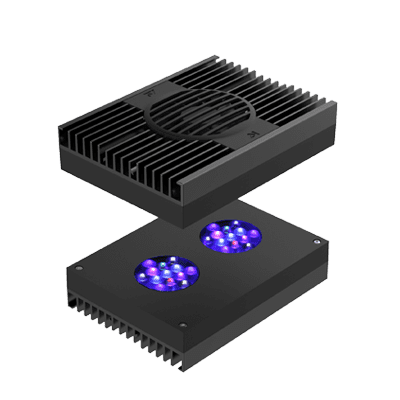
Illuminating Insights: LED Lighting in Aquariums
Share
Illuminating Insights: LED Lighting in Aquariums 🌿💡🐠
Hey there, aquarium enthusiasts! So, we’ve talked about fish, plants, and substrate, but there’s another component that’s just as essential—lighting! It’s not just about showing off your tank’s dazzling inhabitants and décor; the right lighting can make a world of difference in the health and happiness of your aquatic buddies. Today, let’s shine a light on LED aquarium lighting, the modern-day marvel for aquarium illumination.
Why Light Matters: More Than Meets the Eye
Lighting plays a pivotal role in aquariums, influencing both aesthetic appeal and biological processes. It's crucial for the growth of live plants and coral and impacts the behaviour and well-being of fish. A well-lit tank can make colours pop and bring the underwater world to life!
LED Lighting: A Brilliant Choice
LED (Light Emitting Diode) lights have taken the aquarium world by storm, and for good reasons! They’re energy-efficient, long-lasting, and versatile, offering an array of colours and intensities to suit every tank’s needs.
The Perks of Going LED
- Energy Efficiency: LEDs consume less power, reducing your energy bills and environmental footprint.
- Durability: Say goodbye to frequent bulb replacements; LEDs can last up to 50,000 hours!
- Cool and Collected: Unlike other lighting options, LEDs emit minimal heat, reducing the risk of overheating your tank.
- Customization King: LEDs offer a spectrum of colours and intensities, allowing you to tailor the lighting to your tank’s inhabitants and your aesthetic preferences.
The Role of LED Lighting in Plant Growth
Supporting Photosynthesis
Aquatic plants rely on light to photosynthesize and produce energy. LED lights, especially those with a full spectrum, support healthy plant growth, lush foliage, and vibrant colours.
Colour Temperatures and Spectrum
Understanding colour temperatures and spectrum is key. For planted tanks, a full spectrum with a colour temperature around 6500K (Kelvin) is ideal, mimicking natural sunlight.
Intensity and Duration
Balancing light intensity and duration is crucial. Too much light can lead to algae growth, while too little can stunt plant development. Typically, 6-12 hours of light per day is recommended, but this may vary depending on the specific needs of your aquarium.
Creating a Stunning Visual Display
LED lights can transform your aquarium into a mesmerizing display of colours and shadows. Experimenting with different colours can accentuate the colours of your fish and plants, creating a dynamic, ever-changing aquatic landscape.
Mood Lighting
Playing with different light intensities and colours can create various moods and atmospheres in your aquarium, reflecting different times of the day or even seasons.
Spotlight on Beauty
Strategically placed LED lights can highlight specific areas or inhabitants of your aquarium, drawing attention to unique features, interesting behaviour, or vibrant colours.
How to Choose and Install LED Lighting
Assess Your Needs
Consider the inhabitants of your tank and their specific lighting needs. Planted tanks may require high-intensity, full-spectrum lights, while fish-only tanks may have different requirements.
Measure Your Tank
Ensure the LED light fixture is the right size for your tank to provide uniform illumination. Measure the length of your aquarium and choose a light fixture that fits appropriately.
Installation Tips
- Follow the Manufacturer's Instructions: Proper installation is crucial for optimal performance and safety.
- Positioning is Key: Place the lights to evenly illuminate the tank and avoid dark spots.
- Set Up a Timer: Automate the lighting schedule to maintain a consistent day/night cycle for your aquarium inhabitants.
Maintenance and Safety Tips
- Regular Cleaning: Keep the light fixtures clean from dust and water splashes to ensure longevity and optimal light output.
- Handle with Care: When handling or cleaning the lights, make sure they are switched off and cooled down to avoid any risk of electric shock or burns.
- Monitor Water Temperature: Although LEDs emit minimal heat, monitor the water temperature regularly to maintain a stable environment for your fish.
Final Thoughts: Let There Be Light!
Diving into the world of LED aquarium lighting can be thrilling and rewarding. With a myriad of options available, you can create a visually stunning and biologically thriving underwater oasis. The aesthetic appeal is undeniable, but the real magic lies in providing a balanced, healthy environment for your aquatic family.
So, whether you are a seasoned aquarist or just starting your underwater adventure, embracing LED lighting can be a game-changer. Experiment, learn, and watch your aquarium glow with vitality and beauty!
P.S.: Got any bright ideas or illuminating insights about LED lighting in aquariums? Feel free to share your thoughts, experiences, and tips in the comments below. Let's keep our aquarium communities enlightened and vibrant!
(Note: While this guide aims to illuminate, it's important to consider the specific needs of your tank inhabitants and seek advice from aquarium experts or professionals for tailored recommendations and solutions.)
How did you find this lighting guide? Are you ready to let your aquarium shine in a new light? Keep exploring, and remember, a well-lit tank is a happy tank!